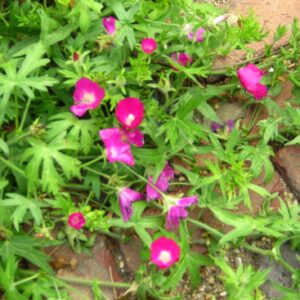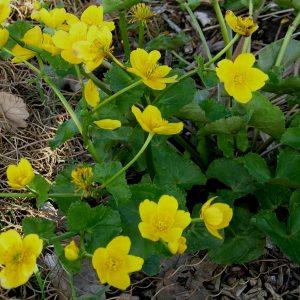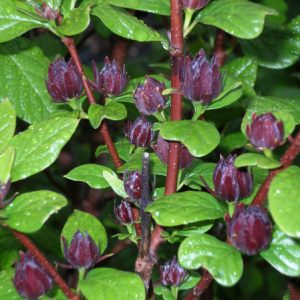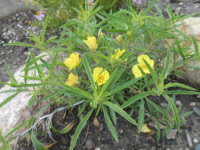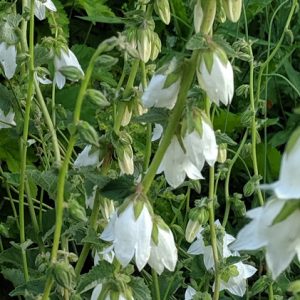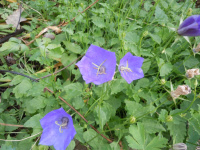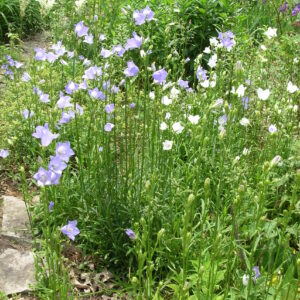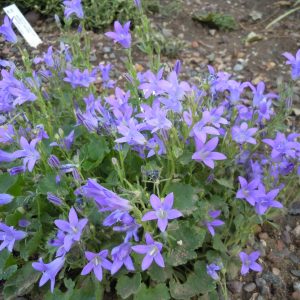Our Plants
Showing 105–112 of 587 results
-
Callirhoe involucrata Wine cups, Prairie poppy mallow Z 3-9
Magenta-purple up-facing cups with white centers, June - October
Magenta-purple up-facing cups with white centers, June – October
Size: 6" x 12-24"
Care: Full sun in well-drained soil.
Native: Missouri to Texas
Wildlife Value: host for larva of Gray Hairstreak butterfly and nectar source for many different butterflies.
Awards: Missouri Botanic Garden Plant of Merit; 1999 Plant Select®; Great Plants for Great Plains Plant of the Year 2020Callirhoe is named for the goddess Callirhoe, daughter of Hermocrates, the Greek river god. Teton Dakota fired the dried root for smoke to cure the common cold and its aches and pains. The liquid used to boil the root relieved internal pain. First collected and named by English plant hunter Thomas Nuttall (1785-1859) but then renamed by other botanists. Ferry’s 1876 catalog described it as having “a trailing habit, of great beauty.” William Robinson (1838-1935), father of today’s mixed perennial border, recognized it to be “excellent for the rock garden, bearing a continuous crop of showy blossoms from early summer till late in autumn.”
-
Caltha palustris Marsh marigold, Kingscup Zones 3-7
Finch yellow buttercups in early spring over round, kidney-shaped foliage
Finch yellow buttercups in early spring over round, kidney-shaped foliage
Size: 12-16” x 12-16”
Care: sun to part shade in moist, acidic soil
Native: Canada to No. Dakota, S to TN, Wisconsin native
Wildlife Value: attracts bees and hummingbirds for nectar. Deters deer – leaves contain mild poison.Caltha is Latin meaning cup and palustris means boggy or marsh. America’s 1st people used the roots medicinally to cure colds and sores and to induce vomiting. The roots also protected against “love charms,” but I suspect vomiting might have done that. An infusion of leaves remedied constipation. Believed to have grown as long ago as the Ice Age. Introduced to Europe very early and memorialized in Chaucer’s poetry, 1549. First described by French botanist Joseph Tournefort c 1700. Grown in the Eichstatt Garden of Prince-bishop Johann Konrad von Gemmingen in Bavaria c. 1600. William Robinson described them as “shin(ing) like fires in swamps and hollows.” Pressed specimen in Emily Dickinson’s herbarium.
-
Calycanthus floridus Carolina allspice, Spicebush, Sweet betties Z 5-9
Fragrant claret flowers in spring through summer.
OUT OF STOCK
Fragrant claret flowers in spring through summer with glossy foliage, fast growing
Size: 6-8’ x 4’
Care: Sun to part shade in rich moist to moist well-drained soil
Native: Penn to FL west to ILCherokee used Spicebush, medicinally to remedy sores on children, and bladder ailments, for hives, as an emetic and to improve poor eyesight. They also poisoned wolves with the seed and concocted a perfume. 1st collected in 1726 then introduced by Mark Catesby who illustrated it in 1730. Offered for sale in Bartram Garden’s 1783 Broadside, America’s 1st plant catalog. Grown by Jefferson. Crushed leaves give off the fragrance of strawberries with a hint of apple. The bark smells like cinnamon and was used as a cinnamon substitute. A favorite in antebellum gardens in the SE. Mary Lacey Tandy reports that she loved Carolina allspice from the time when she grew up in Kentucky, “they used to pinch off a few flowers, crush them and put into a hanky which they pinned to their dresses for the smell.” Pressed specimen in Emily Dickinson’s herbarium.
-
Calylophus serrulatus Yellow sundrops, Shrubby evening primrose Z 4-9
Lemon yellow silky petals bloom late spring to early fall on this tough-as-nails native
OUT OF STOCK
Lemon yellow silky petals bloom late spring to early fall on this tough-as-nails native
Size: 9-18” x 12-15”
Care: sun in well-drained soil, drought tolerant
Native: Great Plains: Central Canada to TX, Michigan to Montana, WI native1st described in 1818 by Thomas Nuttall, English planthunter who collected hundreds of “new” plants in North America. Caly is Greek for calyx; lophos for “the back of the neck; crest of a hill or helmet” serrulatus means “minutely serrate” or “saw-toothed” describing the leaf margins.
-
Campanula alliariifolia syn. C. gundelia syn. C. kirpicznikovii Ivory Bells Z 3-7
July-August, creamy white bells dangle on spires above heart-leaved foliage. Vigorous. Cut back to promote 2nd flowering
July-August, creamy white bells dangle on spires above heart-leaved foliage. Vigorous. Cut back to promote 2nd flowering
Size: 18-24” x 18
Care: sun to part shade in moist well-drained soil
Native: the Caucasus and Turkey
Wildlife Value: attracts bees, butterflies and birdsCampanula is Latin meaning “little bell.” Described by Carl Ludwig von Willdenow in 1798
Highly touted by Graham Stuart Thomas, who once referred to it as a “picture of poise and beauty,” -
Campanula carpatica Tussock bellflower, Carpathian bellflower Z 3-8
In summer blue, violet or white bells
In summer blue, violet or white bells.
Size: 12” x 12”
Care: Sun moist well-drained soil
Native: Carpathian mountains in central Europe
Awards: England’s Royal Horticultural Society Award of Merit.Campanula is Latin means little bell. In 1629 Parkinson described campanulas as “cherished for the beautie of their flowers…” Young roots of this species were eaten in “sallets.” Introduced to European gardens from the Carpathian Mountains in 1774. Sold by McMahon’s Philadelphia nursery in the early 1800’s. Probably cultivated by Jefferson at Monticello.
-
Campanula persicifolia Peach-leafed bellflower Z 3-8
June – July (with deadheading) white or blue open-facing bell flowers along the top foot of the erect, leafless stems.
June – July (with deadheading) white or blue open-facing bell flowers along the top foot of the erect, leafless stems.
Size: 24-36" x 10"
Care: Sun in moist well-drained soil.
Native: EuropeCampanula is Latin meaning little bell. Persicifolia means leaves like a peach. Both white and blue ones of C. persicifolia grew in English gardens before 1580, then described in literature by Scottish botanist Robert Morison (1620-1683). English herbalists prescribed C. persicifolia for ailments of the mouth and throat and to clear complexions.
-
Campanula portenschlagiana Dalmatian bellflower Z 4-8
Purple, upfacing bells for months in mid to late summer
Purple, upfacing bells for months in mid to late summer
Size: 4-6” x 20”
Care: full sun-part shade in moist well-drained soil
Native: Northern Yugoslavia
Awards: England’s Royal Horticultural Society Award of Merit. Top rated Chicago Botanic Garden & Elisabeth Carey Miller Botanical Garden Great Plant Pick.Campanula is Latin meaning “little bell.” 1st described in Systema Vegetabilium 5: 93 in 1819 by one of its discoverers, Franz Edler von Portenschlag-Ledermayer (1772-1822).

